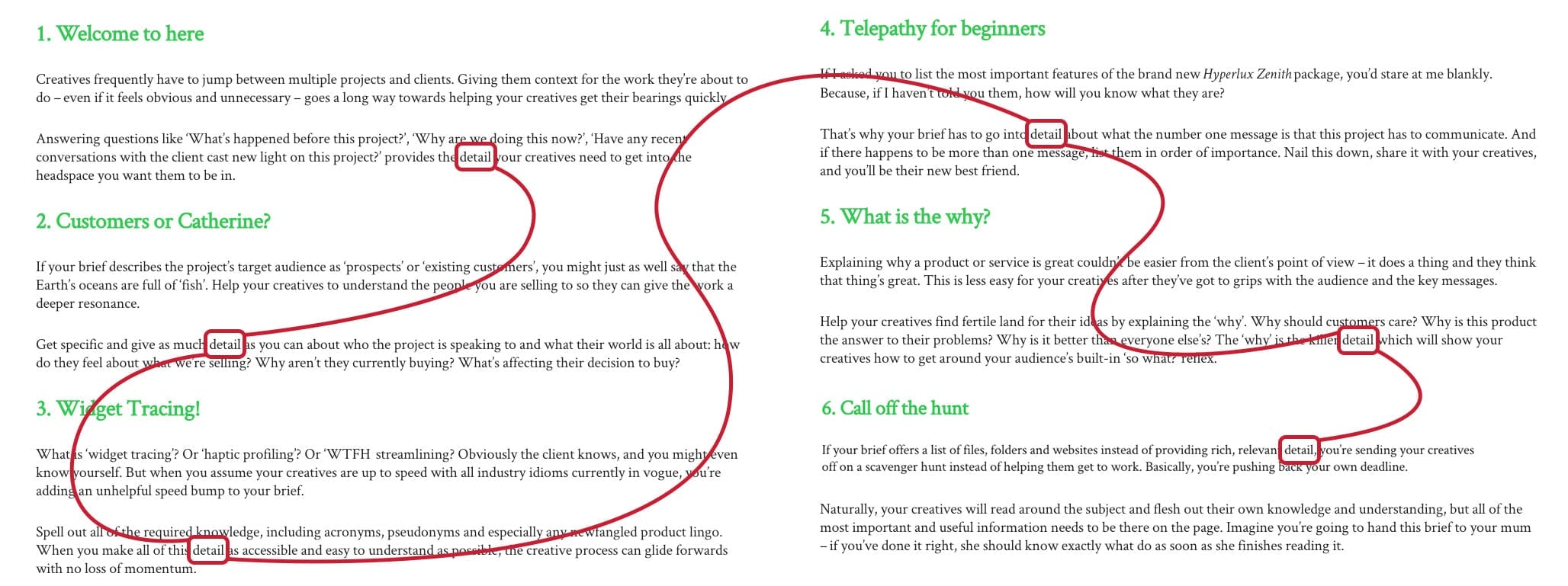How to serve up a refreshing creative brief

Writing a good creative brief is a lot like mixing a good cocktail.
Add too much of ‘this’ and it’ll leave a bad taste in people’s mouths. Add too much of ‘that’ and it’ll make people pass out.
Now, you may feel that you can whip up a zesty creative brief as effortlessly as you might mix a gin and tonic. Your creative department, however, may not entirely agree.
They’re far too polite to tell you this, but the briefs they receive are occasionally missing a few key ingredients and can sometimes give them a nasty headache that lasts for days.
If you want to serve up something that’ll really blow your creatives’ socks off without giving them double vision, here are six simple things you can do to make sure all your briefs hit the spot:
1. Welcome to here
Creatives frequently have to jump between multiple projects and clients. Giving them context for the work they’re about to do – even if it feels obvious and unnecessary – goes a long way towards helping your creatives get their bearings quickly.
Answering questions like ‘What’s happened before this project?’, ‘Why are we doing this now?’, ‘Have any recent conversations with the client cast new light on this project?’ provides the detail your creatives need to get into the headspace you want them to be in.
2. Customers or Catherine?
If your brief describes the project’s target audience as ‘prospects’ or ‘existing customers’, then you might just as well say the Earth’s oceans are full of ‘fish’. Help your creatives to understand the people you are selling to so they can give the work a deeper resonance.
Get specific and give as much detail as you can about who the project is speaking to and what their world is all about: how do they feel about what we’re selling? Why aren’t they currently buying? What’s affecting their decision to buy?
3. Widget Tracing!
What is ‘widget tracing’? Or ‘haptic profiling’? Or ‘WTFH streamlining? Obviously the client knows, and you might even know yourself. But when you assume your creatives are up to speed with all industry idioms currently in vogue, you’re adding an unhelpful speed bump to your brief.
Spell out all of the required knowledge, including acronyms, pseudonyms and especially any newfangled product lingo. When you make all of this detail as accessible and easy to understand as possible, the creative process can glide forwards with no loss of momentum.
4. Telepathy for beginners
If I asked you to list the most important features of the brand new Hyperlux Zenith package, you’d stare at me blankly. Because, if I haven’t told you them, how will you know what they are?
That’s why your brief has to go into detail about what the number one message is that this project has to communicate. And if there happens to be more than one message, list them in order of importance. Nail this down, share it with your creatives, and you’ll be their new best friend.
5. What is the why?
Explaining why a product or service is great couldn’t be easier from the client’s point of view – it does a thing and they think that thing’s great. This is less easy for your creatives after they’ve got to grips with the audience and the key messages.
Help your creatives find fertile land for their ideas by explaining the ‘why’. Why should customers care? Why is this product the answer to their problems? Why is it better than everyone else’s? The ‘why’ is the killer detail which will show your creatives how to get around your audience’s built-in ‘so what?’ reflex.
6. Call off the hunt
• • •
(Header photo: Sara Cervera on Unsplash)
Detail.
Detail is the most important element in every brief. But this does not mean you need to compose a twenty-page opus with endless footnotes and a voluminous bibliography. It simply means: ‘not vague’.
So remember to think of every new brief like it’s a brand new cocktail recipe and ask yourself: have I listed all the key ingredients? Are the preparation and serving instructions easy to follow? Do my party people have any dietary requirements I should consider? What questions might they ask about its contents? And so on.
If anything is missing from the recipe, it simply isn’t going to taste very good. Get it right, and a good brief will give your creatives the kind of buzz that wins awards.
• • •
(Header photo: Sara Cervera on Unsplash)
That’s right, it’s…
Detail.
Detail is the most important element in every brief. But this does not mean you need to compose a twenty-page opus with endless footnotes and a voluminous bibliography. It simply means: ‘not vague’.
So remember to think of every new brief like it’s a brand new cocktail recipe and ask yourself: have I listed all the key ingredients? Are the preparation and serving instructions easy to follow? Do my party people have any dietary requirements I should consider? What questions might they ask about its contents? And so on.
If anything is missing from the recipe, it simply isn’t going to taste very good. Get it right, and a good brief will give your creatives the kind of buzz that wins awards.
• • •
(Header photo: Sara Cervera on Unsplash)
If your brief offers a list of files, folders and websites instead of providing rich, relevant detail, you’re sending your creatives off on a scavenger hunt instead of helping them get to work. Basically, you’re pushing back your own deadline.
Naturally, your creatives will read around the subject and flesh out their own knowledge and understanding, but all of the most important and useful information needs to be there on the page. Imagine you’re going to hand this brief to your mum – if you’ve done it right, she should know exactly what do as soon as she finishes reading it.
══════════════════
Creme de cafe, Angostura bitters, even edible flowers – there are many flavourful flourishes a seasoned mixologist might add to their cocktail mix. But did you detect the special ingredient above?

That’s right, it’s…
Detail.
Detail is the most important element in every brief. But this does not mean you need to compose a twenty-page opus with endless footnotes and a voluminous bibliography. It simply means: ‘not vague’.
So remember to think of every new brief like it’s a brand new cocktail recipe and ask yourself: have I listed all the key ingredients? Are the preparation and serving instructions easy to follow? Do my party people have any dietary requirements I should consider? What questions might they ask about its contents? And so on.
If anything is missing from the recipe, it simply isn’t going to taste very good. Get it right, and a good brief will give your creatives the kind of buzz that wins awards.
• • •
(Header photo: Sara Cervera on Unsplash)
